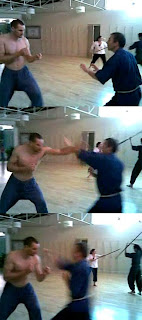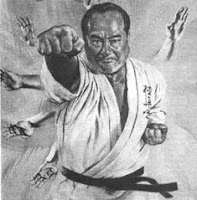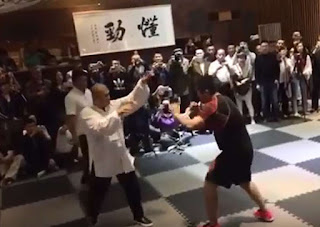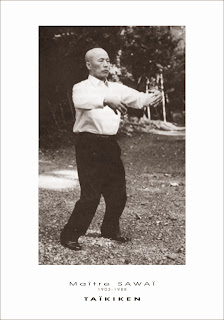Evasion vs. blocking with evasion
I have often been confronted with the argument from modern or eclectic martial artists that karate or other traditional martial arts are deficient because they use what I call "blocks" [ie. parries or deflections] as their primary means of defence rather than purely evasion (as in boxing).
[In relation to the effectiveness of blocks, note my article "Why blocks DO work".]
As I said recently on the fightingarts.com forum, it seems that the above article has at least shifted the debate from "blocks don't work" to the merits of pure evasion over blocking with evasion. The modern martial artists argue that they find pure evasion, more often than not, puts them "exactly where they want to be" in order to attack the opponent, at "exactly the right moment to be there". As one correspondent wrote: "As far as I'm concerned, that's about as good as it gets." I disagree. I think it can get a whole lot better. For some reason they don't seem to think evasion WITH blocking can achieve all that and more. [Once again, remember that I use the term "block" as shorthand for "uke" which means block, parry, deflect etc.]
Necessarily your body has to move further with evasion alone than when your arms are intercepting the attack. When your arm deflects you only need move your body a little.
 Why?
Why?In a karate deflection your hands intercept the attack as close to its source as possible. Here the distance you have to move the attack (or your body) is small. The further the attack extends towards you, the more you have to either shift yourself or shift the attack. This happens with any angle of deflection: the angle is constant, but the further you travel away from the source, the greater the distance between the two axes.
Most importantly you deflect the attack before it has reached full velocity. Compare this to evasion only where you are evading at the point the punch/kick has almost reached full extension and where it is travelling at its full velocity...
Bear in mind too that your body moves much, much slower than your hands do (your hands have far more neurons and are far more dextrous - otherwise you wouldn't use them to write, draw etc.).
I'm not happy to leave out my frontline defence and rely solely on my rearguard - evasion. Rather, I use them together. This not only reduces the size of your evasive movement but also gives you a safety margin. If you use evasion only and your evasion fails you have nothing left to fall back on.
I believe deflection isn't easy in boxing because of glove dynamics, hence it is not a dominant influence on modern fighting sports which are, to a great extent, a product of the long history of Western boxing and similar arts.
And I think the art of deflection as practised in karate is just about forgotten in the mainstream nowadays because of the same influences and a lack of understanding about how and why deflection works. Yet I believe deflection (with evasion) is more effective for barekunckle fighting (again, see my blog article "Why blocks DO work").
Others will argue that when you parry one hand is "tied up". However I never see boxers hitting with both hands at the same time. Rather one hand is hitting (eg. jab), while the other is loading/preparing/chambering (eg. for a right cross). In other words, at the same time as a boxer is slipping/evading, we would use one arm to deflect, loading/chambering the other as the boxer does (but with less body movement needed so we can defend easier and counter sooner).
 In a more sophisticated approach the traditional deflection feeds straight into a counter (see the adjacent picture where the block counter are really part of one flowing/continuous move).
In a more sophisticated approach the traditional deflection feeds straight into a counter (see the adjacent picture where the block counter are really part of one flowing/continuous move).One correspondent countered: "Proper timing/body movement would allow your initial parry to be turned into an offensive jab, with the same follow-up. Two strikes instead of one with no need for parry..." However this is also standard modus operandi in karate - particularly when you're operating at a more experienced level. The blocks or parries are generally strikes as well. In other words, this argues in favour of parrying and against pure evasion...
"But," the argument goes, "evasion has worked far greater than any parry attempts I've ever made..."
Unless you've trained specifically in the art and science of deflection, I am not surprised. It isn't just a question of "attempting" it here or there. It is a specific skill set that isn't taught in most modern martial arts. I've spent my whole martial arts career developing it. You can't just dabble and expect it to work, any more than you can expect to dabble in a bit of grappling or boxing and expect to be good at it.
 What most people think of as "blocking" is the ubiquitous undisciplined "slapping away" of limbs one sees in many purported karate dojos. In this context it is easy to see why the modern martial artists have little time for deflection as a concept. This "slapping" is a poor approximation of traditonal deflection, attempted by people who haven't been instructed how to apply traditional basics in sparring. I see this "slap" fighting as a symptom of dilution of knowledge: too many karateka spend half their time imitating boxers and half their time doing air techniques. Not a good combination...
What most people think of as "blocking" is the ubiquitous undisciplined "slapping away" of limbs one sees in many purported karate dojos. In this context it is easy to see why the modern martial artists have little time for deflection as a concept. This "slapping" is a poor approximation of traditonal deflection, attempted by people who haven't been instructed how to apply traditional basics in sparring. I see this "slap" fighting as a symptom of dilution of knowledge: too many karateka spend half their time imitating boxers and half their time doing air techniques. Not a good combination...Most importantly evasion (ie. in the sense of "moving back or sideways") is a very basic approach in relation to karate taisabaki (body movement). Usually you're moving into the attack, not "evading". Hence you'll notice that in our sparring we're always in what I call the "melee" range - in close quarters, just half a step out of grappling range and half a step out of full kick range. No matter where you go, a blow can land, but at the same time you don't have to close the gap time and time again to land any of your own blows. The karate approach is very offensive, intended to put you in a prime position and teach how to handle the "melee". As I indicated above, you want to catch the attack as early as possible.
Consider by way of contrast the typical range in which boxing type evasion often occurs: The video below is of some free-style karateka doing kickboxing type sparring. I must say that it is rather good (I don't post examples just to denigrate other martial artists, so as a general rule I'll always try to pick someone who I feel has admirable technique). However it does set up a nice contrast with the type of sparring one finds in our school.
Freestyle sparring
One of the things you'll notice is what I describe as the "panic" reaction as soon as they close the gap to the "melee" range. They both start ducking and weaving quite "desperately" (as generally occurs in most "melees"). This is quite common with martial artists who spend most of their time out of range and close the gap for brief periods of heated confrontation. It contrasts quite clearly with our own sparring below where we spend almost all our time in the "melee" range and learn to become more comfortable there. Ring fighting is, in my view, largely about range fighting with the occasional skirmish or grappling: little time overall is spent in "no man's land". On the other hand, civilian defence arts such as karate concentrate on the "melee":
Muidokan sparring
Many have noted the "upright posture" in our sparring and have taken this to be a weakness. They don't see the large ducking, bobbing and weaving movements (at least, not as often). However from a karate perspective it is inadvisable to upset your posture unnecessarily.
Why?
In a ring you have one variable - your opponent. In civilian defence you might simply be unable to duck, weave, dodge etc. You might be shoulder to shoulder in a crowded nightclub, you might be sitting on a barstool, you might be lying on a surfboard waiting for a wave (as happened to one of my students) or standing between 2 parked cars. You don't know whether your attacker has a helper or whether you're going to hit an obstacle that you hadn't paid much attention to as you entered the alleyway etc. where you are being attacked (eg. a low wall). Throwing your head around in self-defence is arguably risky as you unavoidably lose some peripheral perception, particularly with the effect of centrifugal force.
 Consider the adjacent snapshot of the freestyle karate fighters caught in the "melee" range - both are weaving in very large movements. For a protracted fight with one person in fixed surroundings this might be okay. But for a "strike and run" scenario, a big weave might just put your head into his (hitherto unseen) mate's knee. If the attack can be thwarted without the weave - eg. by intercepting the blow with your own hands together with a correspondingly smaller body movement - this is regarded as preferable from karate's civilian defence perspective. Maintaining more of your balance and posture are given primary importance in the "hit fast and get away as soon as you can" philosophy that distinguishes self-defence from sport. Learning to dominate no-man's land - the "melee" - is crucial to this, where sports-oriented disciplines are about lengthy tactics aimed at scoring a "win".
Consider the adjacent snapshot of the freestyle karate fighters caught in the "melee" range - both are weaving in very large movements. For a protracted fight with one person in fixed surroundings this might be okay. But for a "strike and run" scenario, a big weave might just put your head into his (hitherto unseen) mate's knee. If the attack can be thwarted without the weave - eg. by intercepting the blow with your own hands together with a correspondingly smaller body movement - this is regarded as preferable from karate's civilian defence perspective. Maintaining more of your balance and posture are given primary importance in the "hit fast and get away as soon as you can" philosophy that distinguishes self-defence from sport. Learning to dominate no-man's land - the "melee" - is crucial to this, where sports-oriented disciplines are about lengthy tactics aimed at scoring a "win".In other words karate is more conservative about upsetting your vertical posture (and risking being caught off-balance if your evasion is thwarted or interrupted) because it is geared at short self-defence encounters, not protracted one-on-one duels. It is about conservative movement, not about scoring a knockout. It is about defending, not winning. Sports have a different objective. In self-defence you "win" even if you don't land a blow - provided you are unharmed. Of course you might have to harm someone - badly if need be. I'm not advocating "deflecting with no striking". But the fundamental motivation is still not to "beat" your opponent, but not to be beaten. This has a subtle, but significant flow-on effect to your combat.
Then there are the inevitable arguments about "getting around your guard", etc. In other words, "isn't your reliance on your limbs for deflection dangerous". Yes it has its pitfalls. But I think you'll agree that despite our "upright posture" and lack of "head/body moving" our approach seems to protect the head fairly effectively nonetheless.
We don't train for protracted "Octagon" type fighting. For self-defence one needs to specialise in the "melee" range in order to deal with an emergency and not be dominated. Using your limbs more to catch the attack early (which is not really possible in gloved sports), and keeping your posture and peripheral vision in case of obstacles and multiple opponents (not an issue in ring fights) are a karateka's priorities. As with other traditional close quarter fighting schools, we train specifically for this "melee" range, not only in our sparring but with our embu (see below) and various "melee-type" drills (including the Filipino drill "De cadena" - also below).
De cadena - a good drill for the melee
In any event, karate does use movements like weaving and dodging - particularly when one or both hands are incapacitated but sometimes just because it is the best defence against a particular technique. Consider our seiyunchin kata embu which features only traditional techniques and note -
(a) how it keeps the fight in the "melee" range for training purposes; and
(b) uses a weave, among other defensive methods.
I happen to think that it looks much more like real self-defence fighting than any kickboxing type duel.
The seiyunchin embu, complete with traditional karate "weaving" and a constant "melee range"
Copyright © 2008 Dejan Djurdjevic



When doing basic blocks against basic head level punches, one of the instructors, with a kyokushin karate background, saw that I was putting my arms up at shoulder level, hands in front of face, and extended with the left overlapping the farthest area, and the right covering the nearest, rib area. Whereas he thought the block was supposed to be where my hands were at my head or cheeks, defending like a boxer. The latter method required me to weave my head first, in order to get a good angle to then block reflexively. Since I was required to stand still, and not move my legs, that didn't seem too efficient to me at the time, so I used my personal preference to begin with. The more weaving I had to do, the more time it took me to set my weight into an offensive setup to launch an attack. The more chances that my weight would be caught mid transfer, as my feet was on tip toes doing the shuffle dance, and thus unable to power my defense or offense.
ReplyDeleteI followed along with the exercise via his version, but what I left unsaid was that I thought it was a very inefficient version, especially for/from karate. There was no way in hell the newbies around had the timing and/or reflexes to do that kind of evasion + delayed blocking. It wasn't going to benefit them in a real altercation. They would have been better set to practice dynamic evasion with their legs, and just leave their arms down all the time, as it would give them a better defense via range.
For me, I could benefit from all kinds of training. I just make some personal modifications here and there, whether internally or externally, and it's good to go, for me at least. Maybe not 100% efficient as better training methods, but not 0% usefulness either. But I got the sense that not everyone was doing things like that.
Overall, I prefer the wing chun philosophy as described by Jin Young. Where one uses the angle, and avoids weaving the head, because it disrupts the spinal alignment, which is a source of internal power. Angles sets up defensive and offensive opportunities. Weaving doesn't exactly do that as efficiently.
Then again, I notice that a lot of sports doesn't really do much with angles. Even pro MMA fighters seem to say that dealing with angles is too much to think about during some of the TMA practice bouts. That whole primary leg being in front thing is also strange. It really takes away the whole weight transfer component in a lot of their moves. Instead, they transfer weight just to evade. Then they have to retransfer to get back into range, allowing opponent to reset their position and hands. It doesn't have a lot of offensive uses given that much time delay.